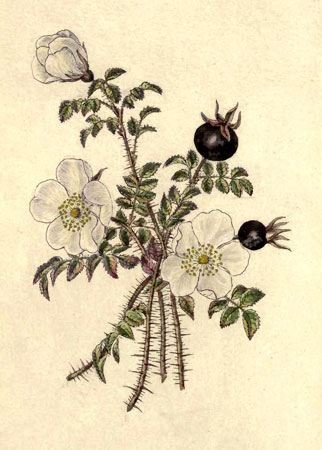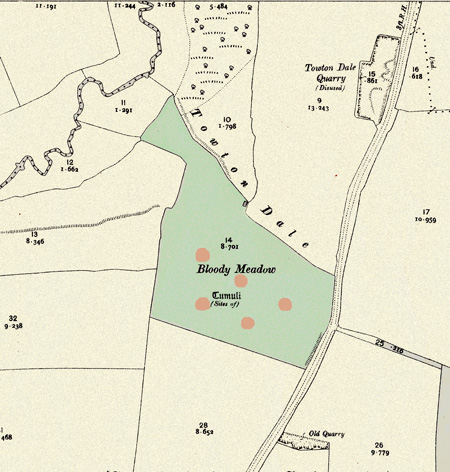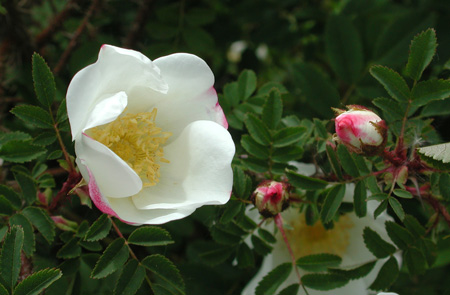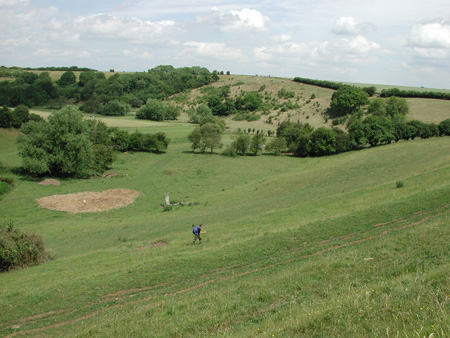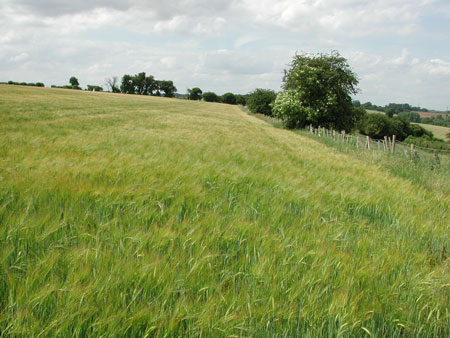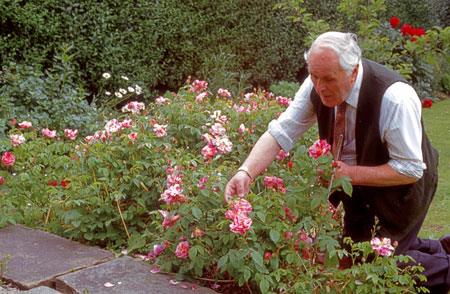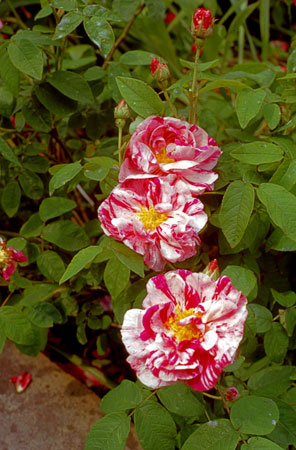Publications
Welcome
to peterboyd.com
Peter
D. A. Boyd
Towton
Roses: fact and fable
Parts
1 and 2 combined
Peter
D. A. Boyd
Web
version of
BOYD,
P.D.A. 2010. Towton Roses, Fact and Fable: part 1 (early history). In
The Towton Herald (the newsletter of the Towton Battlefield Society).
Issue 52 (Winter 2010-2011), pp. 3-11.
AND
BOYD,
P.D.A. 2011. Towton Roses, Fact and Fable: part 2 (later history). In
The Towton Herald (the newsletter of the Towton Battlefield Society).
Issue 53 (Spring 2011), pp. .
[The
Battle of Towton took place near Towton in Yorkshire in the year 1461, between
Yorkist and Lancastrian forces, during the Wars of the Roses. About 30,000
men were killed in the bloodiest battle that ever took place on British
soil. A wild rose, known as 'The Towton Rose' or 'The Battle Rose' grew
abundantly on the battlefield.]
I wrote
an introduction to the story of 'The Towton Rose' in the Summer 2010 edition
of The Towton Herald (Boyd, 2010). [Online
version available]
This article
attempts to document the different accounts of 'The Towton Rose' and provide
a critical analysis of them. Many of the sources are not readily available
so I have reproduced the relevant passages here with their references so
that other researchers can follow them up if they wish.
Original
descriptions of 'The Towton Rose' identify it as a form of the native wild
rose species Rosa spinosissima (also known as Rosa pimpinellifolia),
whose vernacular names include Scots Rose, Scotch Rose, Burnet Rose and
Cat Rose. Later, its identity became confused with other native species
and a cultivated rose, Rosa gallica 'Versicolor' (often known as
'Rosa Mundi').
Rosa
spinosissima showing its small leaves,
prickles and bristles on its stems and black heps (illustration from
Weeds and Wild Flowers by Lady C.C. Wilkinson, 1858).
Although
Rosa spinosissima is probably most widespread on coastal sand dunes,
it does occur inland, particularly on limestone. It favours the Magnesian
Limestone areas of Yorkshire and is still widespread but it has disappeared
from some of its former sites (probably including the battlefield) and is
less abundant on others having been destroyed by ploughing, herbicides and
other agricultural activity over the last 150 years or so.
The Rev.
G. F. Townsend, Vicar of Brantingham, Yorkshire wrote the earliest published
account that I have found of the Towton Roses (Townsend, 1848). He had visited
the battlefield in July 1846 and collected slips (cuttings) of the roses:-
"Palm
Sunday chimes were chiming
All
gladsome thro' the air,
And
village churls and maidens
Knelt
in the church at pray'r;
When
the Red Rose and the White Rose
In
furious battle reel'd;
And
yeomen fought like barons,
And
barons died ere yield.
When
mingling with the snow-storm,
The
storm of arrows flew;
And
York against proud Lancaster
His
ranks of spearmen threw.
When
thunder-like the uproar
Outshook
from either side,
As
hand to hand they battled
When
the river ran all gory,
And
in hillocks lay the dead,
And
seven and thirty thousand
Fell for the White
and Red.
When
o'er the Bar of Micklegate
They
changed each ghastly head,
Set
Lancaster upon the spikes
Where York had
bleached and bled.
There
still wild roses growing,
Frail
tokens of the fray -
And
the hedgerow green bear witness
Of
Towton field that day."
"There
is a patch of wild white roses that bloom on a battle-field,
Where
the rival rose of Lancaster blush'd redder still to yield;
Four
hundred years have o'er them shed their sunshine and their snow,
But
in spite of plough and harrow, every summer there they blow;
Though
rudely up to root them with hand profane you toil,
The
faithful flowers still fondly cluster round the sacred soil;
Though
tenderly transplanted to the nearest garden gay,
Nor
cost, nor care, can tempt them there to live a single day!
I
ponder'd o'er their blossoms, and anon my busy brain
With
banner'd hosts and steel-clad knights repeopled all the plain.
I
seem'd to hear the lusty cheer of the bowmen bold of York,
As
they mark'd how well their cloth-yard shafts had done their bloody work;
And
steeds with empty saddles came rushing wildly by,
And
wounded warriors stagger'd past, or only turn'd to die,
And
the little sparkling river was cumbered as of yore
With
ghastly corse of man and horse, and ran down red with gore.
I
started as I ponder'd, for loudly on mine ear
Rose
indeed a shout like thunder, a true old English cheer;
And
the sound of drum and trumpet came swelling up the vale,
And
blazon'd banners proudly flung their glories to the gale;
But
not, oh! not to battle did those banners beckon now -
A
baron stood beneath them, but not with helmed brow,
And
Yorkshire yeomen round him throng'd, but not with bow and lance,
And
the trumpet only bade them to the banquet and the dance.
Again
my brain was busy: from out those flow'rets fair,
A
breath arose like incense-a voice of praise and prayer!
A
silver voice that said, " Rejoice! and bless the God above,
Who
hath given thee these days to see of peace, and joy, and love;
Oh,
never more by English hands may English blood be shed,
Oh,
never more be strife between the roses white and red.
The
blessed words the shepherds heard may we remember still,
Throughout
the world be peace on earth, and towards man goodwill."
"Oh,
the red and the white Rose, upon Towton Moor it grows,
And
red and white it blows upon that swarthe for evermore -
In
memorial of the slaughter when the red blood ran like water,
And the victors
gave no quarter in the flight from Towton Moor:
When
the banners gay were beaming, and the steel cuirasses gleaming,
And
the martial music streaming o'er that wide and lonely heath;
And
many a heart was beating that dreamed not of retreating,
Which, ere the
sun was setting, lay still and cold in death:
When
the snow that fell at morning lay as a type and warning,
All
stained and streaked with crimson, like the roses white and red
And
filled each thirsty furrow with its token of the sorrow
That wailed for
many a morrow through the mansions of the dead.
Now
for twice two hundred years, when the month of March appears,
All
unchecked by plough or shears spring the roses red and white;
Nor
can the hand of mortal close the subterranean portal
That gives to
life immortal these emblems of the fight.
And
as if they were enchanted, not a flower may be transplanted
From
those fatal precincts, haunted by the spirits of the slain;
For
howe'er the root you cherish, it shall fade away and perish
When
removed beyond the marish of Towton's gory plain".
References
Abbott, P. P. 2005. Plant
Atlas of Mid-West Yorkshire. Yorkshire Naturalists Union.
Baines, Henry. 1840.
Flora of Yorkshire. Longman, Orme, Brown, Green and Longman. London.
Bogg, Edmund. 1904. The
Old Kingdom of Elmet the land 'twixt Aire and Wharfe .
Boyd, P.D.A. 2010a. A
Quest for 'The Towton Rose'. In The Towton Herald (the newsletter
of the Towton Battlefield Society). Issue 51, pp. 6-8. Online
version available
Grainge, William. 1854.
The Battles and Battle Fields of Yorkshire from the earliest times to the
end of The Great Civil War. York: Published by James Hunton; London: A.
Hall & Co. p.76.
Hickes, Martin. 2010.
Search for the Towton Rose stirs echoes of carnage The Yorkshire Post
14th June 2010 (including quotes by Peter Boyd, Peter Algar and others).
Hookham, Mary Ann. 1872.
The Life and Times of Margaret of Anjou. Vol. II. p.122. Tinsley Brothers,
London.
Houlder, E. 2004. The
rose of the wars. Dalesman (September 2004). vol. 66 No. 6.
Lambert, Norman. 1931.
The white rose and the red: memories of a famous fight. In Rose
Annual 1931. The National Rose Society.
Leadman, A. D. H. 1891.
Proelia Eboracensia: Battles Fought in Yorkshire, treated Historically
and Topographically. Bradbury, Agnew and Co.
Lees, F. A. 1888. Flora
of West Yorkshire. Lovell Reave & Co. London.
Lees, F. A. 1904. The
Wild Flowers of Elmete. In Bogg (1904).
Parkinson, Rev. Thomas.
1888. Yorkshire Legends and Traditions. Elliott Stock. London. pp.189-193.
Perfect, William and
John. 1777. William and John Perfect: A catalogue of forest-trees, fruit-trees,
ever-green and flowering-shrubs, sold by William and John Perfect, nursery-men
and seeds-men, in Pontefract, Yorkshire. 1777. York: Printed by C. Etherington.
Pickford, John. 1870.
Towton Field. In Notes and Queries. Fourth Series. Vol. 6. pp.1-3.
London.
Planché, J. R.. 1872.
The Recollections and Reflections of J. R. Planché. vol. 2. Tinsley
Brothers. London.
Ravensworth, The Earl
of [Liddell, Henry Thomas]. 1859. The Field of Towton Moor. In Blackwood's
Edinburgh Magazine 1859 Vol. LXXXV. January 1859. pp. 94-95. (American
Edition Vol. XLVIII)
Ravensworth, The Earl
of [Liddell, Henry Thomas]. 1877. Poems. Dodsworth. Newcastle-on-Tyne.
pp. 90-91.
Speight, Harry. 1902.
Lower Wharfedale: Being a complete account of the history, antiquities
and scenery of the picturesque valley of the Wharfe. Elliot Stock. London.
Telford, John and George.
1775. John and George Telford: A catalogue of forest-trees, fruit-trees,
ever-green and flowering-shrubs, sold by John and George Telford, nursery-men
and seeds-men, in Tanner-Row, York. York: Printed by A. Ward, in Coney-Street.
Townsend, G. F. 1948.
On the Battle of Towton or Palm Sunday Field. In Memoirs Illustrative
of the Antiquities of the County and City of York communicated to the Annual
Meeting of the Archaeological Institute of Great Britain and Ireland held
at York, July, 1846, with a General Report of the Proceedings of the Meeting,
and Catalogue of the Museum formed on that Occasion. The Archaeological
Institute. London. pp. 12-17.
Wheater, W. 1884. Towton
in the Past. In Smith, William. 1884. Old Yorkshire. Longmans,
Green & Co. London. p.41-42.
Whellan, T. and Co. 1855.
History and Topography of the City of York and The North Riding of Yorkshire.
Vol. I. John Green. Beverley. p.161.
White, Walter. 1858.
A Month in Yorkshire. Chapman and Hall. Piccadilly. p.3.
Wilkinson, Lady C. 1858.
Weeds and Wild Flowers: their uses, legends, and literature. London:
John van Voorst. pp. 218-220.
*I
should be very grateful if you could contact me if you know of the whereabouts
of an original 19th or early 20th century painting, photograph, herbarium
specimen or living plant of the true Towton Rose*
